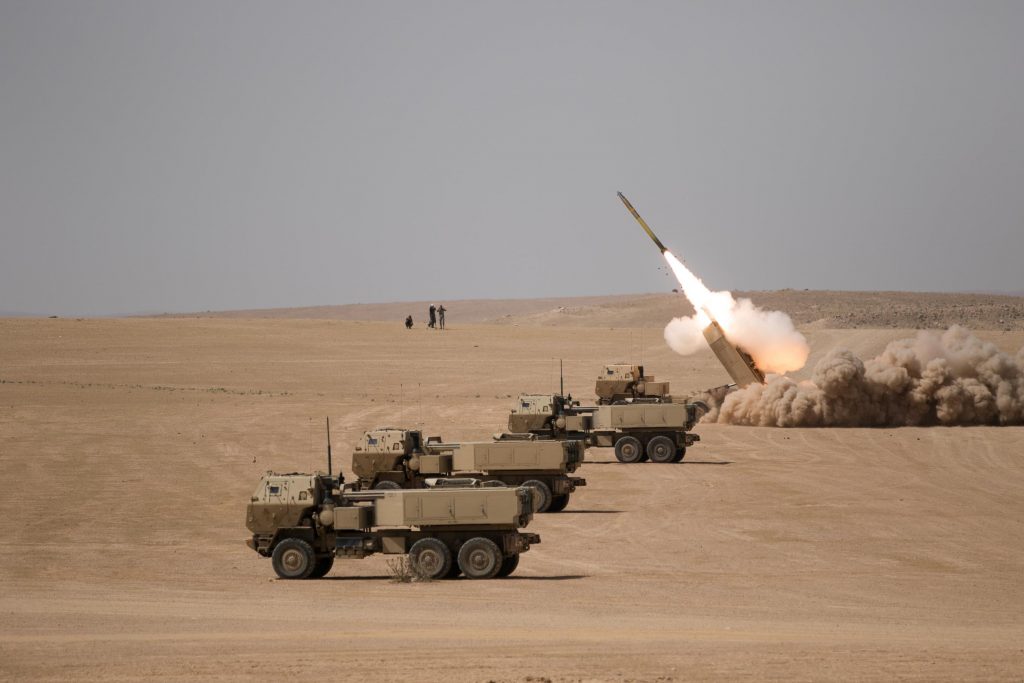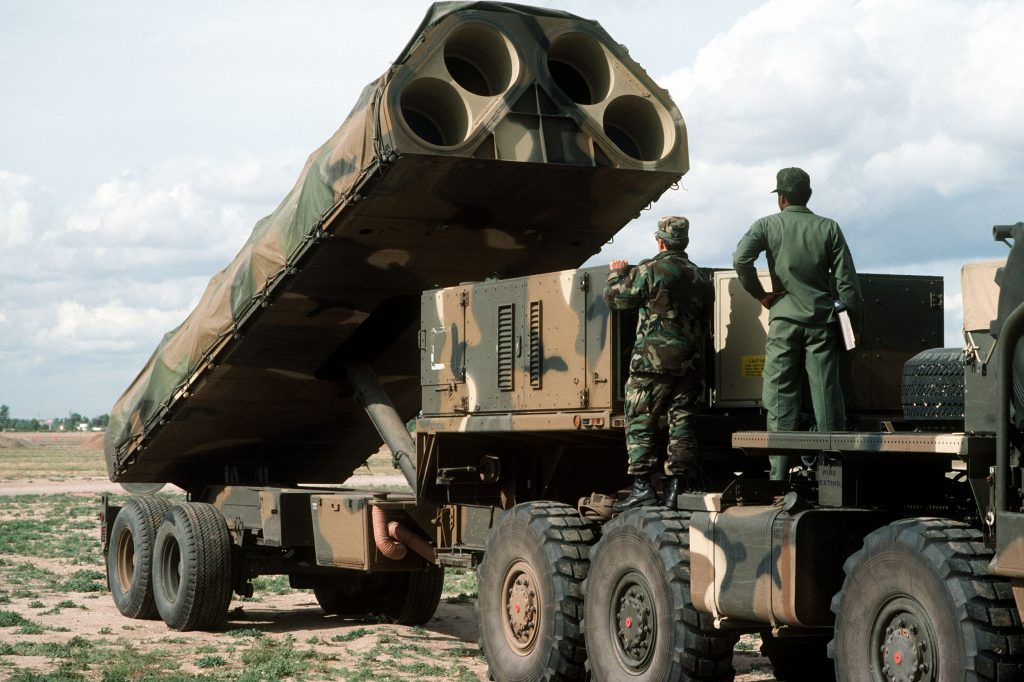
WASHINGTON: Does America need more missiles? The Democrats set to chair key House committees would say “no,” lest we trigger a new nuclear arms race by abandoning the 1987 INF Treaty.
But a cadre of leading national security experts argue “yes” — not to punish the Kremlin for its violations of the Intermediate Range Nuclear Forces treaty, which despite its name covers non-nuclear weapons as well, but to keep up with Russia and China as they arm for a new kind of long-range, precision-guided conventional war.

What Congress Can’t Stop (And What It Can)
No matter who controls the Congress, the legislature can’t stop the executive branch from withdrawing from the INF Treaty. But withdrawing from INF, by itself, does less than nothing for US security. It just removes the last fig-leaf of restraint on Russian violations, letting them build more of the INF-noncompliant missiles they already have in production, at the same time as they get to blame the US for blowing up the treaty.

Modern Tech in Indo-Pacific Operations
Explore how networked warfare, AI, and 3D-printed drones are reshaping US Indo-Pacific strategy.
The only way withdrawal could strengthen US forces — setting aside the very real possibility of an arms race that hurts both sides — is if we actually take advantage of it by building weapons the treaty now prohibits. President Trump has said “we are going to develop the weapons,” but even with a Republican Senate, a Democratic House can block any such program.
An impasse between House and White House could give us the worst of both worlds, a win-win for Putin: No treaty to restrain the Russians, but no US weapons to match them, either. Such an impasse is entirely possible.

It’s also possible that the president’s promised withdrawal is merely Trumpian bluff and bluster, intended to intimate the Russians or rile up voters without ever actually going anywhere. One significant clue: The State Department has not formally filed the six-month notice required to leave the treaty. But assuming that Trump means what he says about withdrawing, that longtime arms control critic John Bolton remains National Security Advisor, and that the 2020 budget request really cuts $33 billion from defense even as it adds new programs — all probable but not certain in this turbulent administration — the administration is on a clear collision course with at least two top Democrats.
“We will neither support, nor enable, a precipitous course of action that increases the risk of an unconstrained nuclear arms race,” wrote Rep. Adam Smith and Eliot Engel — the presumptive chairmen of the House Armed Services and Foreign Affairs Committees — in an Oct. 24 letter protesting President Trump’s promise to withdraw from the Intermediate-Range Nuclear Forces treaty. “It would divide our allies and play directly into President Putin’s hands.”
“Our strength is in our alliances, not in adding yet one more exotic new weapon or nuclear delivery platform,” the Democrats declared. “There has been no Department of Defense decision on testing or deploying ground-launched INF-range missiles that would require or justify withdrawing from the INF Treaty.”

The Non-Nuclear Option
Over and over, in the Smith-Engel statement and elsewhere, INF proponents emphasize the risk of nuclear weapons. But, despite its name, the treaty bans any ballistic or cruise missile with a range between 500 and 5,500 kilometers (about 310 to 3,400 miles), regardless of its warhead. While nukes always loom grimly in the background, it’s non-nuclear, precision-guided missiles that have changed how war is actually waged.
Since the 1991 Gulf War, with its infamous video of Tomahawk cruise missiles going through specific windows, precision firepower has been the long arm of American hegemony. But the Russians and Chinese watched those videos too, so since 1991, they have been investing increasingly in both long-range smart weapons of their own and ways to counter America’s. China, in particular, was never party to the INF treaty and has hundreds of intermediate-range ballistic and cruise missiles, most of them conventionally tipped.

So what? Arms control advocates say the US has plenty of non-nuclear options that allow it to respond conventionally, without violating the INF treaty. That’s because the narrowly written 1987 pact bans only ground-launched missiles, and the US already has plenty of weapons on planes, ships, and submarines.
Even the Vice-Chairman of the Joint Chiefs of Staff, Air Force Gen. Paul Selva, told the Senate last year — before Trump changed the Pentagon’s longstanding pro-INF policy — that there was no need to abrogate the accord because “we’re not restricted from fielding ballistic missile or cruise missile systems that could be launched from ships or airplanes under the Intermediate Nuclear Forces Treaty. It is specific to land-based missiles.”
In fact, the US is already investing heavily in new long-range air and naval weapons, from the B-21 Raider stealth bomber to an upgunned variant of the Virginia-class submarine to multiple new types of air- and sea-launched cruise missile to complement the long-serving Tomahawk. “We have multiple ways to deal with it,” said Alexandra Bell of the Center for Arms Control & Non-Proliferation. “It just seems the Army wants a piece.”

But relying on air and seapower assumes that planes, ships, and submarines will be able to get within range of their targets. Sure, US forces have been able to do so at will since 1991, but that doesn’t mean they will still be able to in the future, because adversaries like Russia, China, and even Iran are working hard on stopping them. The result is batteries of precision-guided, conventional missiles — both anti-aircraft and anti-ship — linked to radars and other sensors by command-and-control networks, and often backed by weapons ranging from advanced fighter aircraft to primitive naval mines.
The arcane term of art for this approach is Anti-Access/Area Denial, but Pentagon officials increasingly dislike “A2/AD” because it implies keeping American forces out is a sure thing. Instead, they prefer to discuss finding the weak points in such defensive systems and breaking them down through multi-domain operations, so called because they apply relentless, coordinated pressure from every angle: land, sea, air, space, and cyberspace.
But there’s one glaring problem with this approach: For all our firepower from the air and sea, US ground forces are “outranged and outgunned” by their Russian and Chinese counterparts, to quote then-Lt. Gen. H.R. McMaster. That doesn’t just make the Army a weak sister to the Air Force and Navy in multi-domain warfare. It means the US lacks the exact kind of long-range weapons that would best survive the opening salvos of the next great-power war.

Why Land-Based Weapons?
The fundamental advantage of ground forces? Dirt is dirt cheap.
Humans aren’t born with wings or fins, so even moving through the air or sea requires expensive special equipment. Once you’re flying through the air, there’s nothing to hide behind, so evading radar requires a mix of jamming and stealth. Likewise, there’s nothing to hide behind at sea except the surface of the water itself, and submarines are much more expensive pound-for-pound than surface ships. But all it takes to move your missiles around on land is a bunch of trucks — and all it takes to hide them from long-range sensors is driving into a parking garage, dense forest, or tunnel, all of which are available for free.

So compared to aircraft, ships, and submarines, land-based launchers can be smaller and cheaper, more numerous and better hidden. Because the cost per shot is lower, truck-borne missiles are the cheapest way to get the massed firepower required to hit large numbers of targets in a major war. And trucks in tunnels can be even harder to find and kill than subs under the sea, something that Russia, China, Iran, and, especially, North Korea have exploited for decades with fleets of mobile launchers.
“Ground-launched systems (are) the most survivable,” said retired Maj. Gen. Bob Scales, the famously innovative former commandant of the Army War College and an artilleryman by training. “It’s a problem the North Koreans posed to us beginning in the mid-1970s that we have never been able to address.”
It doesn’t even take tunnels: Remember how the US struggled to find Saddam Hussein’s Scud launchers, and that was in a largely featureless desert. That’s why the US needs to field its own long-based, long-ranged missiles, advocates argue. “It’s basically a Scud hunt, except it’s our Scuds,” said Tom Karako. “We’re forcing the other guy to do the Scud hunt.”
The head of the missile defense program at the centrist Center for Strategic & International Studies, Karako argues that defending against Russian or Chinese-style massed missile batteries requires more than anti-missile technologies like Patriot or THAAD: It requires new tactics he calls “distributed defense,” spreading your forces out in smaller packets and hiding them in uneven terrain. Instead of 172-foot-wide B-2 bombers carrying twenty 2,000-pound bombs apiece, or 377-foot-long Virginia submarines carrying 12 Tomahawks each, you can have a battery of 23-foot-long HIMARS trucks, each carrying just a missile or two. Each individual launch vehicle is a lot harder to find, and if the enemy does find one and destroy it, their successful strike only took away a small percentage of your firepower.

Most European allies would not welcome such US weapons on their soil, but some closer to Russia probably would, notably Poland with its offer to build a “Fort Trump” for US forces. “Imagine the Polish countryside littered with CONEX boxes or trucks,” each of which could hold a launcher, Karako said. “Some of them are full, many are empty, but the bad guys don’t know where they are and which ones are which.”
If such ground-based weapons can deploy, disperse, and dig in before the war begins — none of which is guaranteed — they could survive the enemy salvo in sufficient numbers to strike back. That counterstrike, in turn, could blow holes in the enemy defenses that allow the less survivable but more mobile air and sea forces to break through.
“I don’t think what doomed INF is Russia’s cheating,” Scales told me. “What doomed INF is the changing character of warfare.” It’s similar to how the rise of the aircraft carrier helped undermine the Washington Naval Treaty of 1921, he said, or how medieval militaries ignored papal decrees not to use the new-fangled crossbow against fellow Christians.
“You can no longer draw arbitrary lines in terms of range when range becomes the dominant factor in defending your territory,” Scales said. As technologies and strategies inexorably change, he argued, “something like INF, which just draws distant lines in the dirt, becomes irrelevant over time.”
Just what the new era of war will look like, and what weapons the US Army should invest in, for what missions against what adversaries, we’ll delve into in subsequent stories in this series.